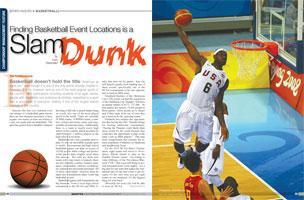
The Fundamentals
Basketball doesn't hold the title "American as apple pie," even though it is one of the only sports actually created in America. It does, however, rank as one of the most popular sports in the country. With participants including students of all ages, adults, people with disabilities and professional athletes, basketball is a sport that is accessible to everyone,making it one of the largest events markets in the country.
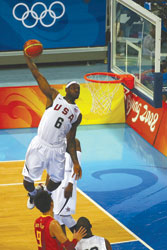 Anyone who has ever watched even one minute of a basketball game knows there are few elements necessary to have a game: two teams, at least one referee, a court, two goals, and one basketball. The sport has grown from a handful of players shooting a ball into a peach basket hung on a pole into one of the most played sports in the world. There are currently 30 NBA teams, 14 WNBA teams, countless college/university teams and innumerable recreational teams. Additionally, there is a team at nearly every high school in the country, which accounts for approximately 1 million players at the high school level alone.
Anyone who has ever watched even one minute of a basketball game knows there are few elements necessary to have a game: two teams, at least one referee, a court, two goals, and one basketball. The sport has grown from a handful of players shooting a ball into a peach basket hung on a pole into one of the most played sports in the world. There are currently 30 NBA teams, 14 WNBA teams, countless college/university teams and innumerable recreational teams. Additionally, there is a team at nearly every high school in the country, which accounts for approximately 1 million players at the high school level alone.
Basketball isn't only a popular sport to play, it's also an incredibly popular sport to watch. Recreational and high school basketball games can draw in excess of 10,000 people while college and professional games draw roughly seven times this amount. Not only are there now teams with long rosters of players, there are also multiple coaches, trainers, managers, cheerleaders, referees, scorekeepers, statisticians, and media personnel. All of these individuals' interests must be taken into consideration when "court"ing basketball events.
Basketball games and tournaments are big business. From a local high school tournament to the NCAA and NBA finals, fans turn out for games. Any city will benefit greatly from landing any of these events, specifically one of the NCAA tournaments or the rare opportunity to land an NBA team.
Elizabeth Buckley of the Oklahoma City CVB, points out that the acquisition of the Oklahoma City Thunder "will have an annual impact of $171,737,588 - 40 plus games per season, 15,000 people at those games. Those people go to dinner and if they came from out of town they get a hotel as do the opposing teams."
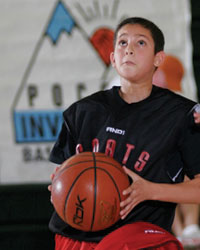 Elizabeth also realizes the opportunities that having the OKC Thunder brings for hosting additional tournaments. "Having the Thunder could likely draw more events for the youth because they could have the opportunity to play on the same court as NBA players." This may seem insignificant, but consider the intense popularity of athletics in Oklahoma and neighboring Texas.
Elizabeth also realizes the opportunities that having the OKC Thunder brings for hosting additional tournaments. "Having the Thunder could likely draw more events for the youth because they could have the opportunity to play on the same court as NBA players." This may seem insignificant, but consider the intense popularity of athletics in Oklahoma and neighboring Texas.
For the 2010 NCAA Men's Tournament, eight teams will travel to Providence, Rhode Island to play at the Dunkin Donuts center. According to John Gibbons, of the Providence/Warwick CVB, "This event will bring in several thousand hotel room nights. It's a big deal for any team that makes the tournament and it's the best event to get because it's the only time you get eight teams in one weekend; it's the biggest bang for your buck."
Obviously not every city will be able to host an NCAA tournament nor will every city be able to land an NBA team. But, as Gibbons points out, "We host other tournaments and the smaller ones bring in as many hotel rooms as the NCAA tournament."
All of these numbers mean one thing: most teams want to be champions and the best in their sport and to do so means they must compete against other teams, which means there must be tournaments, which therefore means someone has to be responsible for putting these events together.
Tip Off
Basketball tournaments require space. Tournaments can range from local school gyms and college arenas to major NBA arenas and civic centers, all within the same event. According to Gibbons "The key to putting on a successful event is finding venues that work for you - it's all about the venues." Pete Kirschner of the Hoop Group adds, "The first thing anyone sees is the venue; they don't see you or the game going on first, it's the venue. And if the ceiling is falling down, they don't care about the games!"
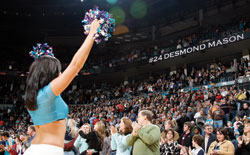 Since tournaments have expanded in size, one venue is not likely enough so an organization considering hosting a basketball tournament of a significant size must be prepared to find multiple venues. Gibbons notes, "We have a major tournament run by Hoop Group and last year there were there 312 teams here. We used 30 courts throughout Rhode Island - at Providence College, Rhode Island College, Community College of Rhode Island - as well as numerous high schools."
Since tournaments have expanded in size, one venue is not likely enough so an organization considering hosting a basketball tournament of a significant size must be prepared to find multiple venues. Gibbons notes, "We have a major tournament run by Hoop Group and last year there were there 312 teams here. We used 30 courts throughout Rhode Island - at Providence College, Rhode Island College, Community College of Rhode Island - as well as numerous high schools."
While it may seem daunting to locate so many locations, organizers don't have to do it alone. "Contact the CVB, we don't cost you any money, we are a free resource to planners, we can help you do so much because we are the experts on our city. We have the relationships with the city so don't overlook us," says Buckley. The CVB staff will also be able to provide the most up-to-date information about the city's venue improvements, including major renovations.
Many sporting arenas throughout the country are in the process of or have recently completed million dollar renovations to their facilities in an effort to provide the best services and opportunities to current and potential clients. These improvements do not go unnoticed and as Gibbons points out, "The renovation of the Dunkin Donuts center helped us acquire the 2010 NCAA Men's Basketball Tournament." This attention to detail can determine whether a sponsoring organization will choose a specific city and it can also weigh heavily on the experience that attendees have.
John Robertson of the Charleston Civic Center in West Virginia is in touch with the needs of basketball tournament organizers and is confident in what his facility provides. "Our facility seats 12,000. We have dressing rooms, easy access to the court, the facility is very easy to get in to, sight lines are good, and easy access to concessions and restrooms. We also offer good parking to teams as well as press entrances, wireless capabilities and telephone and Internet services for the media."
It Takes a Village
When looking for a place to put on a basketball tournament of any level another crucial element is the culture of the city and/or state that is being considered. Is it a city that exclusively rallies around its local teams? Are the residents more interested in professional teams and not as interested in amateur games? Is the city just excited about any opportunity to see great basketball games? Gibbons notes "You want your events to be profitable for the rights holders, meaning generally the community." Kirschner adds, "Know your market and what will drive ticket sales. You don't want to bring a team from Georgia who has a national superstar into an area who'd be happier with their local kid."
Chad Mentzer, sports marketing manager of the Peoria CVB, also cites the value of the community's support. "Peoria is rich in basketball history. It doesn't matter what tournament we bring in, the community supports basketball. The community is crazy for basketball."
...And the Crowd Goes Wild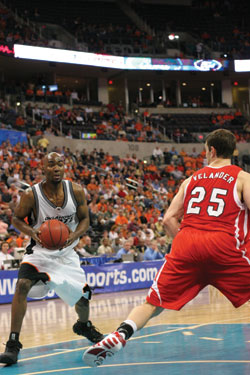 Because many recreational, high school, and college tournaments draw a large number of teams, who in turn draw a large number of supporters, one of the primary concerns of any event organizer or host is spectator seating and crowd control. "On the state high school tournament, crowd management is a challenge so we have to plan for the unexpected," says Robertson. Beth Sauser, assistant executive director of the Illinois High School Association agrees. "Have your staff be aware so they can head things off at the pass. Emotions run high in any athletic contest so you can always have a couple of people who might need attention. When a team makes it to the state tournament there are fans who attend that aren't aware of our sportsmanship policies and we are there are to remind them."
Because many recreational, high school, and college tournaments draw a large number of teams, who in turn draw a large number of supporters, one of the primary concerns of any event organizer or host is spectator seating and crowd control. "On the state high school tournament, crowd management is a challenge so we have to plan for the unexpected," says Robertson. Beth Sauser, assistant executive director of the Illinois High School Association agrees. "Have your staff be aware so they can head things off at the pass. Emotions run high in any athletic contest so you can always have a couple of people who might need attention. When a team makes it to the state tournament there are fans who attend that aren't aware of our sportsmanship policies and we are there are to remind them."
Paying close attention to the needs and interests of the spectators can make a significant difference in the success of a tournament. Robertson adds, "From Wednesday to Saturday we have 80,000 people in our facility. Making it comfortable, having concessions that are stocked with the kind of items people want, offering variety, so that those who come to every event don't end up with the same hot dogs and hamburgers every day is important."
Kirschner supports these thoughts by citing the importance of equal treatment. "Treating people differently is something organizers should avoid. If Mike Jordan walks into the room, don't pay him more attention than so and so Jones because they both paid the same amount. Worry about everyone at the same time and make sure they are all getting treated like super stars."
On the Air
Attention to media is another crucial piece of the event organizers puzzle. In fact, Mentzernotes, "The biggest mistake people make is the marketing of the tournament. Some think they can just pick a date and venue but nobody's going to show up if they haven't promoted it."
Most, if not all, CVBs will help with advanced promotion of a tournament. Brian Hodge, marketing coordinator for the Providence/Warwick CVB says, "We try to accommodate event producers as much as possible. We help with PR and we will even create a website for the organizer to drive traffic to their event so they can promote the details of the event."
Gibbons and Hodge of Providence, both acknowledge the impact an event like the NCAA tournament can make. "The NCAA tournament only comes around to a city every 5-10 years but you can't really measure the impact that being mentioned by media can have on the city. National commentators mentioning the city is huge for us," says Hodge. But, as Kirschner points out, "Media coverage is different at the college level, but it's all relative. You're going to have bigger newspaper, radio, and television coming to a college event, but high schools will have local coverage, but they all should be treated equally."
Post-Game Report
The bottom line for any organization or city looking to host a basketball event of any size is that preparation is essential, outstanding venues are paramount and appropriate accommodations are a must. Without proper preparation, though, no event is going to be successful and to ensure that all media coverage is positive,organizers must plan well in advance. The Hoop Group plans at least one year in advance and they have teams committing a year and a half ahead of time. Their marketing plan and event details are distributed between six and eight months ahead of the event and each day after that is spent with various other details including finding part-time staff, referees, hotel rooms and other amenities.
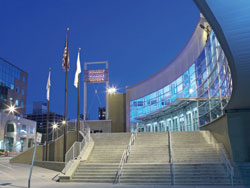 In addition to planning ahead and working closely with venue staff and CVBs, Sauser brings up something most organizers won't consider. "Have a weather plan, whether it's an outdoor or indoor tournament. Don't be surprised by tornado warnings or an ice storm, where power can be cut off." She stresses the importance of knowing what to do with fans and teams in the event of a power outage because "once a season something happens weather wise that can't be controlled."
In addition to planning ahead and working closely with venue staff and CVBs, Sauser brings up something most organizers won't consider. "Have a weather plan, whether it's an outdoor or indoor tournament. Don't be surprised by tornado warnings or an ice storm, where power can be cut off." She stresses the importance of knowing what to do with fans and teams in the event of a power outage because "once a season something happens weather wise that can't be controlled."
Basketball events are about building a fan base. People will make the trip back to a city to see their favorite team if they have a favorable experience the first time. Robertson cautions, "You can't take anything for granted - if you want it to be successful it requires pre-planning and teamwork." And as John Gibbons puts it, "It's important to have a desirable destination that is affordable and don't price someone out of the market. It's easier to keep an existing customer than it is to find a new one."
Basketball Organizations:
Amateur Athletic Union
International Basketball Federation
International Olympic Committee
National Basketball Association
National Collegiate Athletic Association
National Federation of State High School Associations
National Wheelchair Basketball Association
Native American Basketball Tournaments
Women's National Basketball Association

